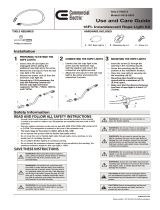
Guardian Fall Protection 6305 S. 231st St., Kent, WA 98032 USA phone: (800) 466-6385 fax: (800) 670-7892 www.guardianfall.com
2
Product Specific Applications
!
WARNING
Use of equipment in unintended applications may result in serious
injury or death. Maximum 1 attachment per connection point.
For all applications: worker weight capacity range
(including all clothing, tools, and equipment) is 130-310 lbs.
Personal Fall Arrest: VLAs may be used in Personal Fall Arrest applications to support a MAXIMUM
1 Personal Fall Arrest System (PFAS). Structure must withstand loads applied in the directions
permitted by the system of at least 5,000 lbs. Maximum free fall is 6‘. MAXIMUM combined length
of fall arrester, lanyard extension, and D-ring is 36”. Applicable D-ring: Dorsal.
Restraint: VLAs may be used in Restraint applications. Restraint systems prevent workers from
reaching the leading edge of a fall hazard. Always account for fully deployed length of lanyard/VLA.
Structure must withstand loads applied in the directions permitted by the system of at least
1,000 lbs. No vertical free fall is permitted. Restraint systems may only be used on surfaces with
slopes up to 4/12 (vertical/horizontal). Applicable D-rings: Dorsal, Chest, Side, Shoulder.
Limitations
Fall Clearance: There must be sufficient
clearance below the anchorage connector to
arrest a fall before the user strikes the ground or
an obstruction. When calculating fall clearance,
account for a MINIMUM 2’ safety factor, deceleration
distance, user height, length of lanyard/SRL,
harness stretch, and all other applicable factors.
Diagram shown is an example fall clearance
calculation ONLY.
Swing Falls: Prior to installation or use, make
considerations for eliminating or minimizing all
swing fall hazards. Swing falls occur when the
anchor is not directly above the location where a
fall occurs. Always work as close to in line with the
anchor point as possible. Swing falls significantly
increase the likelihood of serious injury or death
in the event of a fall.
Compatibility: When making connections
with VLA, eliminate all possibility of roll-out.
Roll-out occurs when interference between
a hook and the attachment point causes the
hook gate to unintentionally open and
release. All connections must be selected
and deemed compatible with VLA by a
Competent Person. All connector gates must
be self-closing and self-locking, and
withstand minimum loads of 3,600 lbs. See
the following for examples of
compatible/incompatible connections:
- Use in Fall Arrest requires a shock absorbing element in PFAS. In the absence of a shock absorber
integrated into rope, it must be present in the Fall Arrester used in combination with rope
(positioning device or rope grab used with shock absorbing extension lanyard).
Fall clearance calculation shown based on standing
worker falling directly in-line with anchor point.
Always consider potential swing fall and other
hazards when calculating fall clearance.
*Eliminate Swing Fall whenever
possible! If Swing Fall exists,
always account for additional
fall clearance.
2’








